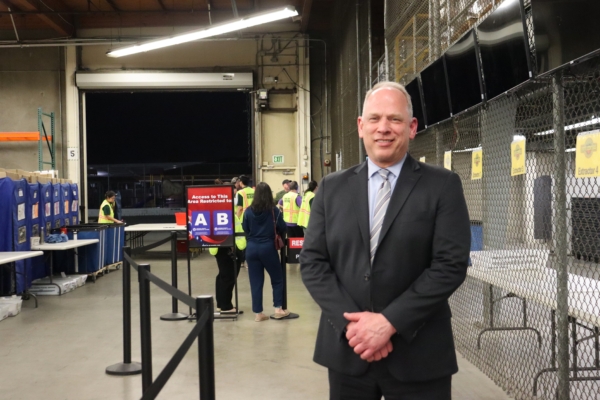Orange County Continues to See Increase in Demand for Traditional Voting Methods
Since the implementation of the California Voter’s Choice Act in 2020, Orange County has seen a growing number of residents requesting a return to traditional voting methods. This includes presenting voter identification, voting in person at designated polling stations on election day, not using mail-in ballots (except under special circumstances), and certifying election results on the same day or the day after. Our reporter interviewed the Orange County Registrar of Voters regarding this matter.
Bob Page, the Orange County Registrar of Voters, explained that the Orange County Board of Supervisors made a decision in 2019 to conduct all future elections according to the California SB450 Voter’s Choice Act (2016). This means that voters no longer have to vote at specific polling places in their community (registered address). Instead, they can vote at any vote center on the designated open days, either 11 or 4 days prior to the election day. Previously, voters were only allowed to vote at designated polling stations on election day, with their names not appearing at other polling stations. If they wanted to vote in a different area, they had to use provisional ballots (which may not always be counted); if they moved, they had to update their address and vote at the newly assigned polling station.
Among California’s six counties with over a million registered voters, five counties, including Los Angeles County (5.74 million residents, accounting for one-fourth of California’s total voters), San Diego County (1.98 million), Orange County (1.86 million), Riverside County (1.37 million), and Santa Clara County (1.04 million), have adopted the Voter’s Choice Act. Out of California’s 58 counties, 26 have adopted the new law, while 3 use the All-Mail ballot method, which involves mailing ballots to all eligible registered voters. Despite 29 counties still using the traditional polling station method, these counties account for only 21.8% of the total registered voters.
Page stated that the Voter’s Choice Act is an “investment” that allows voters more time and various ways to cast their votes. Additionally, California law does not allow election officials to require voters to present voter identification.
When the Voter’s Choice Act was passed in 2016, California lawmakers and interest groups believed it would particularly benefit “historically underserved and marginalized minority voting groups,” ultimately increasing voter turnout among communities such as people of color and low-income voters. The new law mandates that qualifying counties must use All-Mail ballots, with one vote center for every 50,000 registered voters. Each vote center covers a larger area than traditional polling stations, accommodating more voters. In Orange County, over 800 community polling stations were replaced with vote centers.
Former Orange County Registrar of Voters Neal Kelley explained on the website why they switched to the Voter’s Choice Act, stating that “simplicity and security” were key factors. The move aimed to provide voters with more options, enhance the voter experience, eliminate voting hassles, and offer a more secure environment, along with thanking voters for their continued trust in handling their ballots.
Some residents have raised concerns about the high costs of setting up vote centers. The Orange County Registrar’s Office responded that running vote centers for 4–11 days requires background checks and training for temporary employees, making it significantly more expensive than having community volunteers work at polling stations on election day. Preparation and training for primary and general elections typically start before mail-in voting begins in early 2024, including about a month of vote counting after election day, making the whole process last about three months.
Another change involves election facilities. In 2019, the Orange County Registrar’s Office signed a contract with Hart InterCivic Inc. to use their voting system starting in 2020, replacing the previous voting equipment. The new system can handle a large volume of in-person voting and mail-in ballots.
Counties using polling stations usually involve voters who are familiar with each other in the community. Switching to vote centers introduces some uncertainty and a more complex, time-consuming process. It allows anyone from any county, including out-of-county voters, to vote at any vote center, with all ballots sent to the county vote center for counting. For a special election for a state senator in the 36th district recently completed, involving 646,000 registered voters in Los Angeles and Orange counties, 158,000 voted, with 94.9% using mail-in ballots. Even if voters bring their mail-in ballots to the county vote center on election day, the process involves several steps like opening ballots, sorting by precinct, signature verification, ballot adjudication, duplication, manual verification of 1% of ballots, and waiting for responses to confirmation notices for provisional and conditional voter registrations.
After understanding the complexity of this process, some residents have expressed their intention to vote in person at vote centers.
This election took 39 days to complete. Why so long? Page explained that state laws require mail-in ballots to be sent out a month ahead, and vote centers to open 11 days before election day. The only adjustment possible is the daily hours when the vote centers are open. It was reported that very few people visited the county vote center on election day.
Since mail-in ballots can be delivered to the vote center within 7 days after election day, getting quick results after the election is also not possible, even with a count of just 158,000 or fewer ballots.
“The certification of the 2018 midterm election results took place on the 24th day after election day, largely due to 117,000 provisional ballots,” Page noted. “Now, California has explicit rules that prevent certifying the results before the 28th day after election day, even if we could finish by the 22nd day, including dealing with 39,000 provisional ballots. In the November 2024 general election, we completed our work by the 22nd day (Thanksgiving), but had to wait until December 3 to confirm.”

